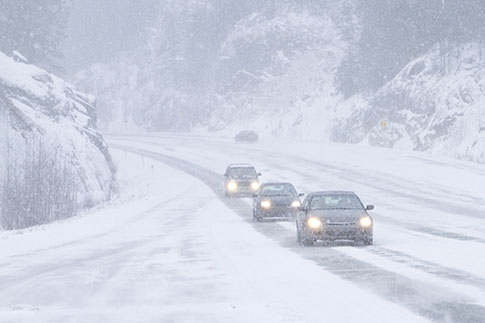Winter driving tips

In winter, the road conditions are more variable, and when they do change, it can happen much faster. It’s therefore important to adjust your driving accordingly. You must also be ready to handle emergency situations, and have a vehicle in good condition to tackle the cold season.
Get your vehicule ready
Winter is very hard on the mechanics of an automobile, and a poorly tuned vehicle may end up being expensive. It is never too late for a good tune-up that includes an inspection of the electrical components, as well as the air-intake, fuel, exhaust, ignition and cooling systems, and a check of the windshield wipers.
It’s always wise to have an emergency kit in the trunk in case of problems. In winter, the emergency kit needs extra equipment: shovel, snowbrush, scraper, traction aids or abrasive materials, and winter windshield wiper fluid. All of these items should be added to those you keep in your vehicle for the rest of the year.
For your safety, you should always have reflective triangles or a reflective vest, a battery-free flashlight, some tools, a first-aid kit, a warm blanket and non-perishable food on board in the event of a breakdown in a remote area.
Slow down
As soon as you suspect that the road surface may be slippery, whether the cause is snow or ice, the golden rule is to ease up on the accelerator. By doing so, you ensure that your tires have more time to grip the road. Likewise, always turn the steering wheel slowly to maintain control of the vehicle.
Practice makes perfect
If you don’t feel entirely confident, you can always go for a practice session, in a large deserted parking lot, for example. Trying out a few turns, braking manoeuvres and intentional skids at a safe speed, without fear of untoward consequences, can’t hurt!
What to do in case of a front-wheel skid
In a skid situation, all will remain well as long as the tires are “biting” the road. But when centrifugal force is stronger than the front tires’ traction, your vehicle will start “pushing wide” of the desired trajectory. This is called understeer.
The front-wheel skid is often caused by excessive speed going into a turn, or the wheels locking up. To stop it, ease up on the accelerator or brake pedal, and steer the wheels in the direction of the turn, while looking in the direction you want the vehicle to go.
Obviously, you must execute your turn gently, which will probably be easy because the wheels are already pointing in the direction you want to go. Be careful, however, when it comes to traction as well as power: if you back off the accelerator too quickly, you may find the rear wheels skidding as well.
What to do in case of a rear-wheel skid
Alternatively, you may notice that the rear end of your vehicle has suddenly begun assuming its own trajectory. This is called oversteer. To counter it, turn the front wheels in the direction in which the back end has started swinging, while, of course, looking in the direction you want to go.
What often happens next is that the back end swings out again, but in the opposite direction (fishtailing). Be ready to repeat the same manoeuvre quickly, but remember to always steer gently. This is a tricky operation requiring great presence of mind: don’t forget, always look in the direction you want the vehicle to go, not in the direction of the skid!

Drive defensively
Avoiding sudden manoeuvres and adjusting your speed to the weather conditions are the basic rules of safe winter driving. But there are also specific conditions you need to watch out for.
A roadway may appear dry, but be covered in so-called black ice. Invisible on the road surface, this ice usually forms when the temperature is hovering around 0°C. Bridges, overpasses and underpasses are all areas where these nasty patches of ice can spell trouble for the inattentive motorist.
When leaving the city to drive into a rural area, road conditions can change suddenly from dry to snow- or ice-covered. The careful driver will therefore reduce speed in this situation, to avoid surprises caused by radically reduced tire adherence.
Reaction time: your best ally!
In the summer months, it is strongly recommended that you follow the “three-second rule” to keep a minimum distance between you and the vehicle ahead. But in the winter, the space between you and the vehicle in front of you should be greater—in severe conditions, you should be able to count up to six seconds or more. The longer the following distance, the more time you will have to make the right decision in an emergency situation, and driving will also be much more pleasant because you’ll be able to better anticipate traffic flow. Think about it the next time you take to the road!
Need advice regarding your vehicle or want to upgrade your membership?

Benefit from personalized advice
Electric or gas-powered cars, RVs, ATVs or motorcycles
Enhance your experience
Switch to the card that best suits your needs.